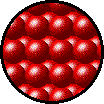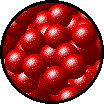The
Particle Theory - states
of matter
 The Particle Model is a 'model' of matter - that means it is a way to make our thinking about the complex reality of matter much simpler.
The Particle Model is a 'model' of matter - that means it is a way to make our thinking about the complex reality of matter much simpler.
It explains most types of matter very well and is easy to picture in our heads.
Rules
for being a 'Particle'
 Particles
are very small - their size is negligible.
Particles
are very small - their size is negligible.
 Particles
are identical - to simplify our model we
will ignore Chemistry - same mass - no awkward shape - no polarity (charge
differences within the molecule)
Particles
are identical - to simplify our model we
will ignore Chemistry - same mass - no awkward shape - no polarity (charge
differences within the molecule)
 Particles
attract one another: the closer they are
the stronger the attraction (therefore in solids and liquids attraction
is very strong but in gases it is negligible).
Particles
attract one another: the closer they are
the stronger the attraction (therefore in solids and liquids attraction
is very strong but in gases it is negligible).
 Particles
are in constant random motion (hence the
word 'kinetic' in the name of the theory - random means no preferred
direction - as many move in one direction as the opposite - all of the
movements are 'balanced' or cancel each other out - no nett (resultant) movement.
Particles
are in constant random motion (hence the
word 'kinetic' in the name of the theory - random means no preferred
direction - as many move in one direction as the opposite - all of the
movements are 'balanced' or cancel each other out - no nett (resultant) movement.
The
motion is a combination of these three types:
 vibrational motion - back and forth about a point
vibrational motion - back and forth about a point
 rotational motion - spinning round - changing direction
rotational motion - spinning round - changing direction
 translational motion - moving from place to place in a straight line.
translational motion - moving from place to place in a straight line.
The arrangement of particles within each of the three main states of matter can be used to explain their general properties.
 In
a solid there is no translation - they
are stuck in a fixed 3-dimensional arrangement (often a 'regular'
arrangement - one with a pattern). In
a solid there is no translation - they
are stuck in a fixed 3-dimensional arrangement (often a 'regular'
arrangement - one with a pattern).
They do not have enough energy to overcome
the attraction from their neighbours - that is why solids are a
fixed shape and size.
They are restricted to rotational and vibrational
movement. The hotter they are the faster they vibrate and rotate
and the further apart they are able to get (that is why objects
expand on heating!).
Solids are often referred to as
a condensed phase because the particles are very close together.
 Solids generally have a fixed shape. They cannot flow to take on new shapes. This is because the particles cannot move from place to place - they have no translational energy. Solids generally have a fixed shape. They cannot flow to take on new shapes. This is because the particles cannot move from place to place - they have no translational energy.
 Solids cannot be easily compressed, squashed or stretched. This is because the particles are as close together as they can be. and therefore have no spaces to move into. Solids cannot be easily compressed, squashed or stretched. This is because the particles are as close together as they can be. and therefore have no spaces to move into.
|
 In
a liquid they are still greatly under
the influence of the particles around them but they are able to
move around - they have translational energy but it is very limited. In
a liquid they are still greatly under
the influence of the particles around them but they are able to
move around - they have translational energy but it is very limited.
They are not in a regular patern at all.
They constantly move and
'mingle' with each other - like a person in a crowd they move in
contorted paths as they weave their way around.
Liquids therefore
have a fixed size - no 'liquid particle' has the energy to escape
completely from its neighbours - but the shape is determined by
the shape of the base of the container that the liquid is poured
into (gravity ensures it settles as low as possible in the gravitational
field - therefore the liquid has a flat surface. (But - see meniscus!).
 It is difficult
to compress liquids because the particles are so closely packed - but
as they slide past each other it is easy to change the shape! It is difficult
to compress liquids because the particles are so closely packed - but
as they slide past each other it is easy to change the shape!
 A
liquid flows easily because the particles can move/slide past one
another. A
liquid flows easily because the particles can move/slide past one
another.
Liquids are often referred to as a condensed phase because
the particles are very close together.
|
|
 In
a gas the particles are so wide apart compared to their size that they are totally free from each other's influence! In
a gas the particles are so wide apart compared to their size that they are totally free from each other's influence!
 A gas
flows easily because the particles can move past one another so
easily. A gas
flows easily because the particles can move past one another so
easily.
The gas particles whizz around in straight lines and their translational
energy is so great that we can ignore the other two forms most
of the time!
Their speeds are very high.
They bump into each other
and the atoms that make up the container they are in.
What produces pressure from a gas?
When gas particles 'bump' into
the container sides they create a 'pressure' on the container
when they change momentum - the faster they move (i.e. the higher the temperature) the harder
they hit the container and the greater the pressure on it - heating
a gas sealed in a container is very dangerous as it can explode
if the pressure gets too great!
All force vectors for the impact with the sides can be resolved into horizontal and vertical components. The components that are perpendicular to the sides of the container create the pressure on the container - the ones parallel to it create no pressure. So pressure is produced by a force at right angles to the surface and therefore by Newton's Third Law we know that the pressure from a gas produces a net force at right angles to any surface.
Changing the temperature of a gas
At low temperature the average kinetic energy is lower - so the pressure is lower. Whereas at high temperatures the average kinetic energy of the gas particles is higher so the pressure is higher.
 No matter how low or high the
temperature is a gas always fills the container it is in because
the particles whizz round and fill the space - it is the pressure
on the container that changes when you adjust the temperature. Increase the temperature and the pressure increses, decrease it and the pressure decreases. No matter how low or high the
temperature is a gas always fills the container it is in because
the particles whizz round and fill the space - it is the pressure
on the container that changes when you adjust the temperature. Increase the temperature and the pressure increses, decrease it and the pressure decreases.
But if the container is flexible (like
a balloon) then the increase in pressure as the gas gets hotter
(and particles move faster) causes the container to expand until
the pressure pushing from the inside of the container (from the
gas) is equal to the pressure on the outside (Atmospheric pressure).
 See Charles' Law. See Charles' Law.
Changing the volume of a gas
If you put a gas in a container that you can change the volume of - such as in a syringe - you can obsrve the effect that changing volume has. If you increase the volume, the pressure on the container will decrease, if you decrease the volume it will increase. This is because you are changing the time interval between gas particles hitting the container sides.
 See Boyle's Law. See Boyle's Law.
|
Animated
gifs: Copyright 2003, Purdue University - Reproduced
with kind permission - click on an image to go through to the
originator's site! |
This is a link to a page of videoclips on the states of matter and this is a link to a page explaining about internal energy of particles (Advanced level).
 to go to a page on changing state to go to a page on changing state
 to go to a page on evaporation and condensation to go to a page on evaporation and condensation
|









